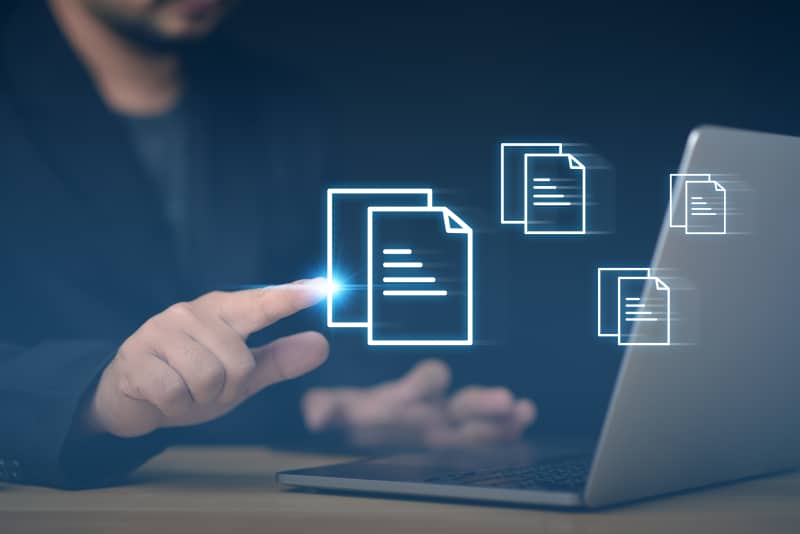In the current age of digitization, organizations are increasingly utilizing document digitization services to quickly convert their important data into electronic versions. Microfilm and microfiche were used to store huge volumes of data. As we embrace the age of information, digitizing microfiche and microfilm becomes a practical necessity. By converting these records into digital formats, we are ensuring enhanced preservation, easy accessibility, and unprecedented opportunities for data analysis. From space-saving solutions and improved searchability to enhanced data security and collaboration, the benefits are manifold.
Twelve Benefits of Digitizing Microfiche and Microfilm
Digital files are much easier to manage, share and edit. Microfiche and microfilm require reader printers to magnify the contents for viewing. When it comes to the context of modern information management and accessibility, digitizing microfiche and microfilm offers numerous benefits:
- Preservation and restoration – Microfiche and microfilm can degrade or disintegrate over time due to physical wear, chemical reactions, or environmental factors. Digitization ensures that the information is preserved in a digital format, reducing the risk of loss or damage to the original physical copies.
- Space Saving – Microfilm quickly gained popularity due to its ability to store thousands of documents in a relatively small amount of space. For instance, a single roll of microfilm can hold up to 2500 images/documents. As compact as microfilm and microfiche are, it can be difficult to store them safely. Digitizing these records allows for significant space savings, as digital files can be stored on servers, hard drives, or cloud storage without the need for physical storage cabinets.
- Instant/Improved accessibility – Accessing information from microfiche or microfilm can be cumbersome, requiring specialized readers and manual searching. In fact, locating a single image out of thousands is difficult enough even in the most ideal circumstances. But once your film or fiche is digitized, all your files are instantly accessible. Digitized files can be easily accessed and searched using computers, allowing for quick retrieval and easy navigation through the data. With digital files, you can type in the name of the file, an ID number, film and frame numbers, or any other data you have stored along with your image and retrieve it instantly. Digitizing your film also takes away the restriction of only being able to access your data from one place, by one person at a time. Digital files can be shared, emailed, and accessed by authorized people outside of your organization. This makes it convenient for multiple teams to share the same data, regardless of physical location.
- Improved search and retrieval – Digital files can be indexed and tagged with metadata, making it easier to search for specific information within the documents. This improves the efficiency of finding relevant data and reduces the time spent on manual searches. After converting microfiche and microfilm, files are indexed, which means that all the information is now keyword searchable. Instead of trying to remember a particular roll of film and then searching through boxes or filing cabinets, you simply type in a word, date, or name and the information will come right up.
- Enhanced sharing and collaboration – Digitized records can be easily shared with multiple users simultaneously. This facilitates collaboration among researchers, employees, or students who can access the information from different locations.
- Data security and backups – Digital files can be protected with encryption and access controls, ensuring data security and privacy. Additionally, regular backups can be performed to prevent data loss due to hardware failures or other unforeseen events.
- Long-term cost savings – While digitization may involve an initial investment, the long-term cost savings can be significant. It reduces ongoing expenses related to physical storage, maintenance of microfilm readers, and manual document handling.
- Format conversion – Digitized microfiche and microfilm can be converted into various file formats, making them compatible with different software and devices. This adaptability feature allows for continued access to the information, even as technology evolves.
- Easy integration with DMS – Digitized records can be seamlessly integrated into existing document management systems. This makes it convenient to consolidate and manage various types of documents in one place.
- Improved document control – Once you have digitized your microfilm and microfiche, information can be password protected. Depending on the kind of content management system you have, you can also restrict access to individual folders or types of information. With digital files, you can make sure that data is accessed only by the people who need to see it.
- Better data analysis – The digitized data can be analyzed using various data mining and analytical techniques. This provides new insights and valuable information that might not have been easily discoverable from the physical records.
- Increased efficiency – As discussed, it takes a lot of time to locate a single piece of information on microfilm or microfiche. The time taken to search documents involves a decent amount of time if you aren’t exactly sure what you are looking for. When it comes to digitized files, employees can do a simple search, find their information, and get on with their day. This helps your staff to devote more time on more valuable or other core tasks.
Digitizing microfiche and microfilm provides a more efficient, accessible, and secure way of managing historical and valuable data. This makes it an essential step for organizations and institutions seeking to modernize their information management practices. Relying on a professional provider that offers microfilm scanning services can help handle the digitization of large volumes of data at cost-effective pricing.
Contact us today to discuss your microfilm scanning needs.




